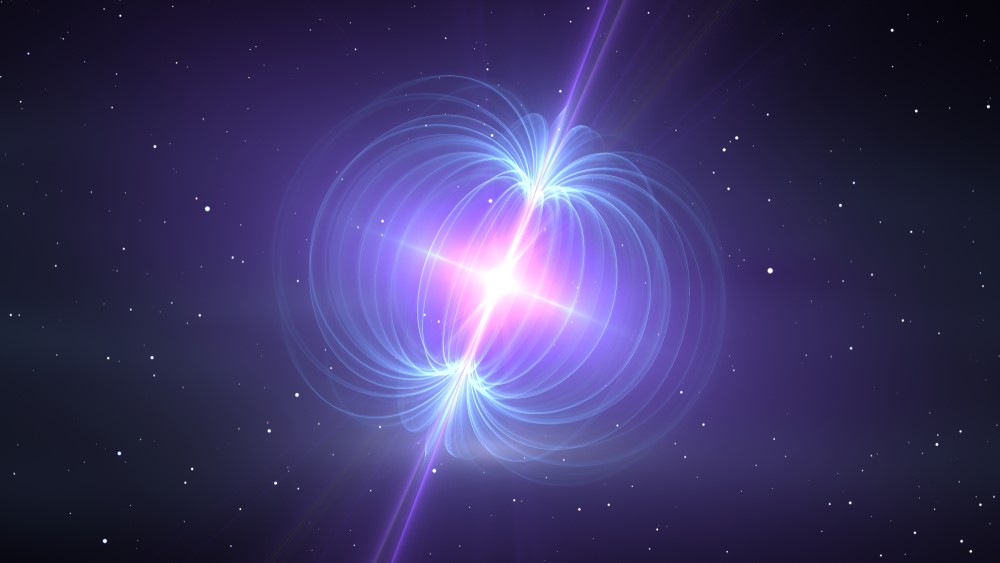Neutron star 'mountains' may be blocking our view of mysterious gravitational waves
These "mountains" may be hundreds of times smaller than previous predictions suggested.
Neutron stars are covered with "mountains" only fractions of a millimeter tall, new research shows, meaning these bumps are hundreds of times smaller than previous estimates had suggested.
Neutron stars are compact stellar objects, similar in size to a large city with a diameter of around 6.2 miles (10 kilometers), that weigh at least 1.4 solar masses (1.4 times the weight of the sun). They are born from the explosive deaths of stars that weigh between 10 and 25 solar masses. As a result, they are some of the densest objects in the universe and have an incredibly strong gravitational field, around 2 billion times stronger than Earth's. This extreme gravity squashes neutron stars into near-perfect spheres that are surrounded by a smooth and solid crust. However, deformations in the crust create mountains on the surfaces of these stars, previous research found.
Now, new findings, presented at the National Astronomy Meeting 2021 in the U.K. on July 19, suggest that these mountains are likely to be hundreds of times smaller than scientists previously thought.
Related: 9 epic space discoveries you may have missed in 2020
"They probably should be called 'bumps' or 'hills,' not 'mountains,'" lead researcher Fabian Gittins, a doctoral student at the University of Southampton in the U.K., told Live Science.
An imperfect sphere
The crust of a neutron star is a solid layer on the outside of the star, similar to Earth's crust, made out of the nuclei of broken-up heavy elements that contain the ultra-dense soup of neutrons within the star, according to Space.com. It is around 0.6 miles (1 kilometer) thick and is the region of the star with the lowest density, Gittins said.
Mountains form when the crust is put under enormous amounts of strain and begins to crack. "There are loads of ways [for] these mountains to form," Gittins said. "All that is required is for the star to change its shape."
Get the world’s most fascinating discoveries delivered straight to your inbox.

Possible explanations for the mountain formation include increased strain from its strong electromagnetic field or the fact that they spin more slowly over time. But it may also be caused by a phenomenon known as glitching, in which the star suddenly starts to spin faster, Gittins said.
But regardless of what causes the mountains to form, their size is limited by the amount of strain the crust can take before it breaks. "The stronger the crust is, the larger the mountains it can support," Gittins said.
Smaller than expected
Gittins and his team predicted the size of neutron star mountains by creating computer models that accurately simulated the crust of a neutron star.
"We subjected these models to a variety of mathematical forces that gave rise to the mountains," Gittins said. "We increased the magnitude of the forces until the crust broke."
This allowed the team to predict the largest possible size of mountains the neutron stars could sustain without breaking. Their new prediction suggests that earlier estimates that pegged these mountains at up to a centimeter tall may have been significantly flawed.
"In looking into this problem, we found that previous studies had technical issues with their approach," Gittins said.
One of the main issues is that previous predictions assumed that the crust of neutron stars was in a shape that strained the crust maximally at every point, but that turned out to be physically impossible, Gittins said. "Our approach did not strain the crust to the maximum at every point but at a single point," he added.
Ripples in space-time
Neutron stars are known to spin rapidly due to the angular momentum they retain from their exploding parent stars, Gittins said.
"When a neutron star that is deformed in an asymmetric way is rotating, it causes ripples in the fabric of space-time around it," Gittins said. "These ripples are known as gravitational waves."
Researchers first detected gravitational waves, emanating from two rotating black holes, using the Laser Interferometer Gravitational-wave Observatory (LIGO) in 2015, Live Science previously reported. LIGO has since detected two separate gravitational wave events resulting from the collision of neutron stars, Live Science previously reported, but solitary neutron stars have remained elusive.
"Currently, we haven't been able to detect gravitational waves from rotating neutron stars," Gittins said. But these nondetections also tell scientists a lot about neutron stars, he added.
The smaller the mountains on neutron stars, the smaller the gravitational waves they produce. Therefore, their lack of detection may support Gittins' predictions.
"Given we know the sensitivity of our detectors, we can place upper limits on how large the mountains on neutron stars must be," Gittins said. "The general trend is that the upper limits are getting smaller and smaller."
Therefore, it may be a while before scientists can build detectors big enough to spot the space-time ripples given off by these rapidly rotating microscopic bumps.
The study was first published online Nov. 21, 2020, in the journal Monthly Notices of the Royal Astronomical Society.
Originally published on Live Science.

Harry is a U.K.-based senior staff writer at Live Science. He studied marine biology at the University of Exeter before training to become a journalist. He covers a wide range of topics including space exploration, planetary science, space weather, climate change, animal behavior and paleontology. His recent work on the solar maximum won "best space submission" at the 2024 Aerospace Media Awards and was shortlisted in the "top scoop" category at the NCTJ Awards for Excellence in 2023. He also writes Live Science's weekly Earth from space series.



